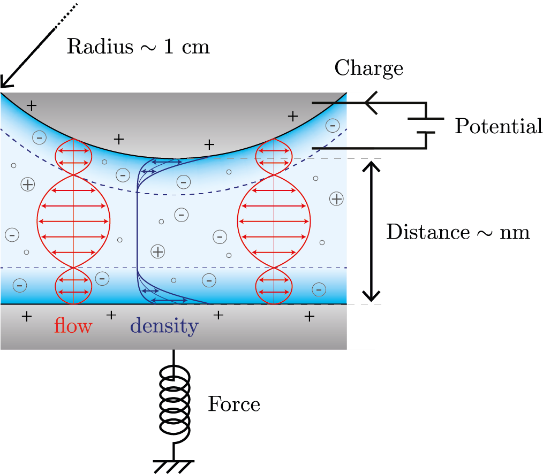- Share
- Share on Facebook
- Share on X
- Share on LinkedIn
Recruitment

Duration: 12 months (Emergence funding from CNRS Physique), possibility of extension
Start date: 1er octobre 2025 at the latest
Salary: From 2991.58€ gross per month (depending on experience and current CNRS salary scale)
Laboratory: Laboratoire Interdisciplinaire de Physique, Grenoble, France
Team: Matière molle : Organisation, Dynamique et Interfaces
Contact : Romain Lhermerout (romain.lhermerout univ-grenoble-alpes.fr (romain[dot]lhermerout[at]univ-grenoble-alpes[dot]fr))
univ-grenoble-alpes.fr (romain[dot]lhermerout[at]univ-grenoble-alpes[dot]fr))
As fluids containing mobile charges, liquid electrolytes are characterized by several transport modes in the bulk: pressure, potential or concentration gradients generate hydrodynamic, electric or ionic fluxes, by advection, conduction or diffusion. Close to a charged surface, the formation of a non-electroneutral interfacial layer (electrical double layer) induces the coupling of transport modes (electrokinetic couplings): a potential gradient causes an electro-osmotic flow, or a concentration gradient causes a diffusio-osmotic current. This rich phenomenology can be exploited in a wide range of energy-related applications, from blue energy harvesting to energy storage in supercapacitors, batteries and fuel cells. However, their performances could be considerably improved with a better fundamental understanding of the physics of transport in nanoconfined electrolytes.
Existing theoretical models, based on a continuous description of matter and on a mean-field treatment of electrostatic interactions, have never been tested experimentally. Indeed, most studies have focused either on equilibrium properties (electrostatic interactions), or transport properties (electro-osmosis, conductivity, etc.), leading to inconsistent interpretations [1].
The experimental approach we are implementing is based on the team's solid experience with the dynamic Surface Force Apparatus [2]. The principle is to confine the electrolyte at the nanometric scale between two macroscopic and conducting surfaces, and in combining mechanical (interaction force) and electrical (capacitance) measurements. This ensures (i) a model geometry of confinement, and (ii) simultaneous measurements of the equilibrium surface charge and electrokinetic couplings.
Recently set up, the instrument has already produced interesting preliminary results. The main objective of this post-doctoral project will be to exploit the instrument's capabilities to study coupled transport in confined electrolytes under well-controlled boundary conditions.
[1] R. Hartkamp, A.-L. Biance, L. Fub, J.-F. Dufrêche, O. Bonhomme and L. Joly, Measuring surface charge: Why experimental characterization and molecular modeling should be coupled, Curr. Opin. Colloid Interface Sci. 37, 101-114 (2018)
[2] L. Garcia, C. Barraud, C. Picard, J. Giraud, E. Charlaix, and B. Cross, A micro-nano-rheometer for the mechanics of soft matter at interfaces, Rev. Sci. Instrum. 87, 113906 (2016)
Expected profile & missions:
An experimentalist with a strong taste for instrumentation, and a background in at least one of the following domains: (soft matter) physics, (fluid) mechanics, electronics, electrochemistry, physical chemistry or material science.
The recruited person:
- will be trained to use the instrument developed in the laboratory,
- will carry out measurement campaigns and will analyse the data obtained,
- will have to modify the measurement protocols and experimental parameters according to the observed behaviours,
- may contribute to the development/adaptation of theoretical models needed to interpret experiments,
- will take part in activities to communicate the results (writing articles, attending conferences),
- may be involved in supervising students.
Application:
Interested candidates should send their application to romain.lhermerout univ-grenoble-alpes.fr (romain[dot]lhermerout[at]univ-grenoble-alpes[dot]fr), including a cover letter, a CV and contact details of 2 referees.
univ-grenoble-alpes.fr (romain[dot]lhermerout[at]univ-grenoble-alpes[dot]fr), including a cover letter, a CV and contact details of 2 referees.
Download
Contact
Romain LHERMEROUT
MODI team
romain.lhermerout@univ-grenoble-alpes.fr
- Share
- Share on Facebook
- Share on X
- Share on LinkedIn